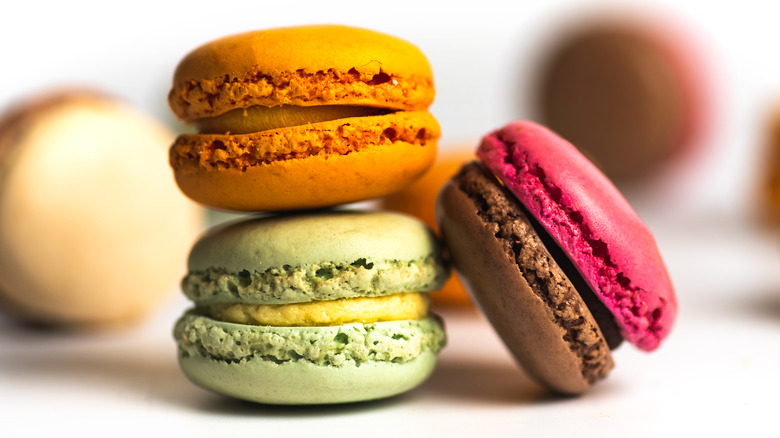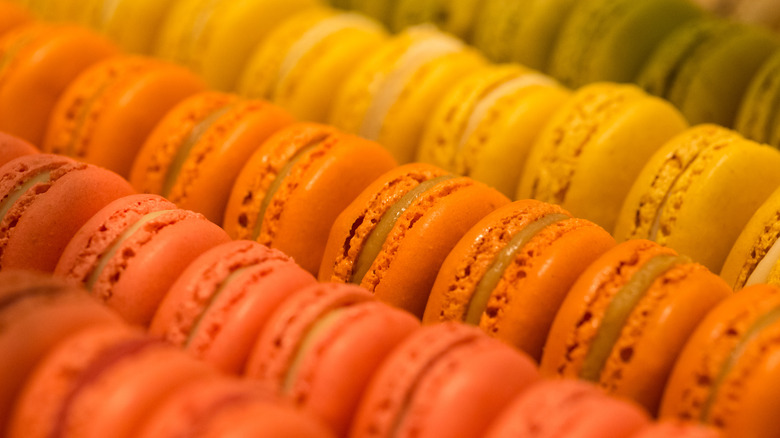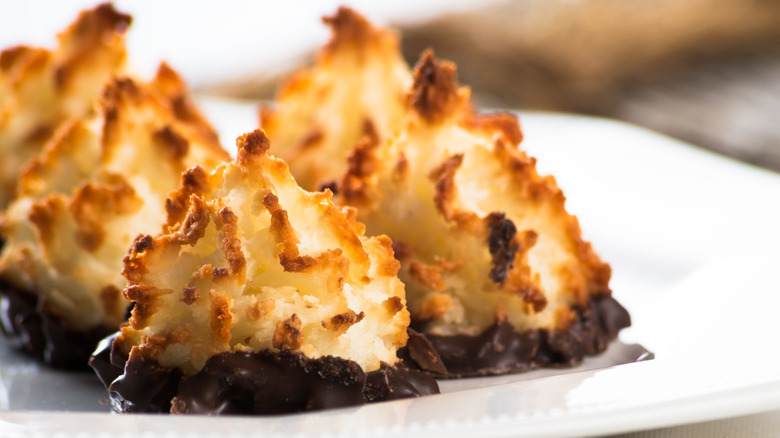The World Of Difference Between Macarons And Macaroons
The two cookies are both egg-white based and gluten-free, but they're very different. Macarons, pronounced "mac-uh-rohns," are delicate, French, sandwich cookies while macaroons, pronounced "mack-uh-roons," are chewy coconut drop cookies popularly eaten as a Passover dessert in the Ashkenazi Jewish community.
Interestingly, they both originated in ancient Italy around the 8th century but evolved in totally different directions. Arab settlers brought almonds with them and Italians created the crackly, chewy, almond-flour based, amaretti cookie. The names macaron and macaroon both likely come from the Italian word for fine paste, maccherone. The macaron, also sometimes called a French macaroon in English, evolved from the amaretti cookie once it made its way to France. Some say the cookie came along with traveling nuns, while others say Catherine de' Medici was a fan and brought them with her from Italy when she married Henry II.
As Jewish people do not consume leavened foods during Passover, the early version of the macaroon took hold. Later variations included nuts, which are still common in Sephardic Jewish traditions. Coconut probably did not become an ingredient until more recently with the invention of shelf stable shredded coconut in the late 1800's. Popular Jewish food companies in the United States began to manufacture tins of coconut macaroons during the Passover season.
How is a macaron made?
The signature slightly chewy, crisp, and delicate texture of a macaron is achieved through a very specific process. Sifted almond flour, sugar, and food dye are carefully folded into egg whites that have been whipped into stiff peaks. The cookie batter is piped into small circles on a baking sheet. Once baked, the cookies grow rounded and glossy and develop a frilly edge around the base.
The puffy borders on each cookie are referred to as the feet and grow as steam escapes during the baking process. These cookies are notoriously finicky though, and small changes in baking temperature or baking time, over- or under-whipping the eggs, and over- or under-mixing the batter can result in a cookie that looks nothing like what was expected.
Once cooled, the macarons are turned into pretty little sandwich cookies, usually filled with a cream, ganache, or jam and are colored to match the flavor. Classic flavors from the iconic La Maison Ladurée, the first macaron bakery founded in Paris in the 1890's, include chocolate, vanilla, pistachio, raspberry, and lemon. Some of the more creative offerings include passion fruit, licorice, and cherry blossom tea. Macarons can also be served in larger sizes, called a macaron géant or gâteau macaron, and eaten like a macaron cake. Macarons Basques from Southern France aren't dyed and are served without fillings. These predate the sandwich varieties and are most similar to the early Italian versions.
How are macaroons made?
Unlike macarons, making macaroons is straightforward and decidedly unfussy. While they continue to be a classic Passover treat, they're also a mainstay for American home bakers when they want an easy, pantry-based, sweet fix. Macaroons also start with egg whites that are whipped into stiff peaks. The egg whites are folded into a mixture of dried coconut, sweetened condensed milk, vanilla, and salt. They are formed into small mounds or pyramids and baked. The resulting cookie is chewy and sweet. The texture varies depending on what type of dried coconut is used (shredded or flaked) and if it's sweetened or unsweetened.
Macaroons are typically served plain or dipped in chocolate but can also be made with variations that complement the flavor of the coconut with the addition of almonds, lime zest, or drizzled in salted caramel. Another fun iteration is often made for Easter. The macaroon cookie mix is formed into the shape of a bird's nest and then decorated with candy eggs once cooled. The macaroon mix can even be the decadent top layer on coconut macaroon brownies.
The vibes of these two cookies are certainly different — one fancy, one a bit more rustic. But either way, you can't go wrong with a sweet treat.



